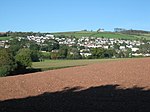Luton, Teignbridge

Luton is a village in Devon, England, within Teignbridge local authority area. Historically Luton formed part of Ashcombe Hundred.The village is in the parish of Bishopsteignton, but has a chapel of ease, dedicated to St John the Evangelist, built in the 19th century. The village is within Kenn Deanery for ecclesiastical purposes. The chapel is a Grade II listed building, as are the lych gate and a tomb in the churchyard. Other listed buildings in the village include the Old Mill, a former watermill inoperative since the 1880s and now a private house, and Ivy Cottage, a 17th- or 18th-century thatched cottage.The village contains a public house, the Elizabethan Inn.
Excerpt from the Wikipedia article Luton, Teignbridge (License: CC BY-SA 3.0, Authors, Images).Luton, Teignbridge
Teignbridge Bishopsteignton
Geographical coordinates (GPS) Address Nearby Places Show on map
Geographical coordinates (GPS)
| Latitude | Longitude |
|---|---|
| N 50.581424 ° | E -3.552122 ° |
Address
TQ13 0BL Teignbridge, Bishopsteignton
England, United Kingdom
Open on Google Maps










